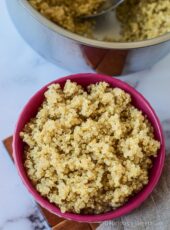Pesarattu, or green lentil crepe, is a tasty yet filling breakfast from South India. It is packed with fiber, protein, and other micronutrients like iron. This Pesarattu recipe is made from a batter of green moong beans ground with spices like ginger, asafoetida, and green chilies.
Want a quick breakfast that will keep you full for a long time? You’ll never go wrong with this delicious Pesarattu recipe. Pair it with your favorite chutney or sambar, and you’ll have a healthy start to the day.

What is Pesarattu?
Pesarattu is a savory crepe made from green gram (whole moong beans) batter. ‘Pesara’ in Telugu refers to Green gram dal and ‘Attu’ means crepe or dosa.
Unlike dosas, which use fermented rice and urad dal batter, Pesarattu is made without fermentation, making it a quicker option for those busy mornings.
This Pesarattu recipe tastes amazing, more like a vegetarian version of omelet. Mom made it for dinner all the time. She would soak it in the morning and grind the batter when she got back from work. We would devour it in minutes!
You can also save the leftover batter in the fridge and use it later.
My fellow working moms , I’m talking to you! You will sing praises of Pesarattu once you start including it in your meals.
Why You’ll Love this Pesarattu Recipe
- Healthy and Nutritious: Made with green gram, Pesarattu is a powerhouse of protein, fiber, and essential nutrients, making it a wholesome meal to kickstart your day.
- Quick and Easy: Unlike traditional dosas, Pesarattu doesn’t require fermentation, saving you time without compromising on taste.
- Versatile and Customizable: You can adjust the spice levels, add toppings of your choice, and pair it with a variety of chutneys to suit your palate.
- Naturally Gluten-Free: For those with gluten sensitivities, Pesarattu offers a delicious and safe protein-rich breakfast option.
- Authentic South Indian Flavor: This dish brings the taste of Andhra Pradesh right to your kitchen, letting you savor the essence of South Indian cuisine.
Check out other breakfast recipes from my blog

Ingredients for this Pesarattu Recipe
1. Whole Green Gram (Moong Dal)
The star ingredient of Pesarattu, whole green gram (moong dal), is a powerhouse of nutrition. Rich in protein, fiber, and essential vitamins, it forms the base of the batter. Its earthy flavor and natural binding properties make it ideal for creating crispy and flavorful crepes. This lentil is a great choice for weight management and boosting energy levels.
2. Raw Rice
A small amount of raw rice is added to the batter to enhance the texture and crispiness of the Pesarattu. It gives the dosa a perfect golden hue and prevents it from being too soft. Rice balances the overall flavor and makes the crepe light and satisfying. It also completes the amino-acid profile of Pesarattu. Perfect for Vegans!
3. Green Chilies
Green chilies add a spicy kick to the batter, elevating the overall flavor profile of the Pesarattu. You can adjust the quantity to suit your spice preference. They not only add heat but also contribute to a fresh and vibrant taste.
4. Ginger
Fresh ginger lends a subtle warmth and aroma to the Pesarattu batter. Its unique flavor enhances the dish while aiding digestion, making it a vital ingredient in this recipe.
Serving suggestion:
- Coconut chutney
- Ginger chutney (Allam pachadi)
Servings and Calories
This Pesarattu recipe serves 4 people (makes approximately 8 medium-sized Pesarattus). Each serving has about 150-180 calories, depending on the toppings and accompaniments.
Step-by-Step Recipe for Pesarattu
Step 1: Soaking the Green Gram
Begin by rinsing the green gram thoroughly under running water to remove any dirt or impurities. Soak it in enough water for at least 6 hours or overnight. If you’re using rice for added crispiness, soak it along with the green gram.


Step 2: Preparing the Batter for this Pesarattu Recipe
Drain the soaked green gram and transfer it to a blender. Add green chilies, ginger, and salt. Blend the mixture with just enough water to achieve a smooth yet slightly thick batter. The consistency should be similar to dosa batter — neither too runny nor too thick.
Add turmeric powder to the batter, and mix well. Adding turmeric powder makes vibrant green Pesarattus and they look very inviting.
If you’d like to make the Pesarattu extra crispy, you can add a tablespoon of rice flour in addition to the rice in the batter.


Step 3: Preparing the Toppings (Optional)
Finely chop the onions, green chilies, and coriander leaves. Mix them in a bowl along with a pinch of asafoetida and salt. Keep this mixture handy, as it will be sprinkled on the Pesarattu while it cooks.

Step 4: Cooking the Pesarattu
- Heat a flat non-stick pan or a cast-iron griddle on medium heat. Ensure the pan is hot but not smoking.
- Pour a ladleful of batter onto the center of the pan and quickly spread it in circular motions to form a thin crepe.
- Sprinkle the prepared topping mixture evenly over the Pesarattu. Gently press the toppings into the batter with the back of a spatula.
- Drizzle a few drops of oil around the edges and let it cook for 2-3 minutes until the edges start to lift and the bottom turns golden brown.
- Flip the Pesarattu and cook for another minute on the other side.
- Remove from the pan and serve hot.
Repeat the process for the remaining batter.



Tips for the Perfect Pesarattu using this Pesarattu Recipe
- Always soak the green gram properly to ensure a smooth batter and better digestibility.
- If you prefer a spicier flavor, you can add more green chilies to the batter.
- Adding turmeric powder makes vibrant green Pesarattus and they look very inviting.
- For a healthier version, you can skip the oil and cook the Pesarattu on a non-stick pan without greasing.
- Pesarattu tastes best when served hot and fresh, so avoid preparing them in advance.

Serving Suggestions for this Pesarattu Recipe
Pesarattu is traditionally served with:
- Ginger Chutney (Allam Pachadi): This spicy and tangy chutney pairs perfectly with the earthy flavor of the green gram.
- Coconut Chutney: A classic accompaniment to almost all South Indian breakfasts.
For a complete Andhra-style experience, you can also serve Pesarattu with a dollop of ghee and a side of upma (a savory semolina porridge). This combination is fondly known as MLA Pesarattu.
I love my husband’s rava upma and I like to pair it with Pesarattu occasionally if I want to indulge myself for breakfast. It’s a heavenly marriage of carbs and protein.
Nutritional Benefits of Pesarattu
- Rich in Protein: Green gram is an excellent source of plant-based protein with nine essential amino acids, making this dish a great option for vegetarians and vegans.
- Low in Calories: With minimal oil and wholesome ingredients, Pesarattu is a guilt-free breakfast choice.
- High in Fiber: The whole green gram provides a good amount of dietary fiber, aiding digestion and promoting gut health.
- Gluten-Free: If you skip the rice or rice flour, Pesarattu is naturally gluten-free, making it suitable for those with gluten sensitivities.
Frequently Asked Questions (FAQs)
3. Do I need to soak the green gram before making this Pesarattu recipe?
Yes, soaking the green gram for 4-6 hours (or overnight) softens it, making it easier to blend into a smooth batter.
4. Can I make this Pesarattu recipe without fermentation?
Yes, Pesarattu batter does not require fermentation. It can be used immediately after grinding.
5. Can I use sprouted green gram for Pesarattu?
Absolutely! Sprouted green gram adds extra nutrition to the dish and works perfectly for Pesarattu.
8. Can I make this Pesarattu recipe gluten-free?
Yes! Skip the rice and rice flour to make it gluten-free.
9. How can I make this Pesarattu recipe crispy?
To make it crispy:
- Spread the batter thinly on a hot tawa.
- Use medium-high heat.
- Drizzle a little oil around the edges.
Cook until the edges turn golden brown.
10. Can I store the batter for later use?
Yes, you can refrigerate the batter for 2-3 days. Stir it well before use, and adjust the consistency with water if it thickens.
12. Is Pesarattu suitable for weight loss?
Yes! Pesarattu is high in protein, low in calories, and rich in fiber, making it a healthy option for weight loss diets.
14. Is Pesarattu suitable for kids?
Yes, it’s a nutritious option for kids. For a milder taste, reduce the green chilies and ginger in the batter.
15. Can I freeze Pesarattu?
While it’s best served fresh, you can freeze prepared Pesarattu in an airtight container and reheat it on a tawa or microwave.
Pesarattu Recipe
Course: Breakfast, DinnerCuisine: South Indian8
pesarattus10
minutes5
minutes300
kcal8
minutesPesarattu, or green lentil crepe, is a tasty yet filling breakfast from South India. It is packed with fiber, protein, and other micronutrients like iron. This Pesarattu recipe is made from a batter of green moong dal ground with spices like ginger, asafoetida, and green chilies.
Ingredients
- For the batter
1 cup green gram (whole moong dal)
2 tablespoons rice (optional, for crispiness)
1-2 green chilies (adjust as per spice preference)
1-inch piece of ginger
Salt to taste
Water – 3/4 cup (adjust water to get the right consistency)
Turmeric powder – ¼ teaspoon
- For the toppings (Optional)
1 small onion, finely chopped
1-2 green chilies, finely chopped
A handful of coriander leaves, chopped
A pinch of asafoetida (hing)
A pinch of salt
Directions
- Begin by rinsing the green gram thoroughly under running water to remove any dirt or impurities. Soak it in enough water for at least 6 hours or overnight. If you’re using rice for added crispiness, soak it along with the green gram.
- Drain the soaked green gram and transfer it to a blender. Add green chilies, ginger, and salt. Blend the mixture with just enough water to achieve a smooth yet slightly thick batter. The consistency should be similar to dosa batter — neither too runny nor too thick.
- Add turmeric powder to the batter, and mix well. Adding turmeric powder makes vibrant green Pesarattus and they look very inviting.
- If you’d like to make the Pesarattu extra crispy, you can add a tablespoon of rice flour in addition to the rice in the batter.
- Finely chop the onions, green chilies, and coriander leaves. Mix them in a bowl along with a pinch of asafoetida and salt. Keep this mixture handy, as it will be sprinkled on the Pesarattu while it cooks.
- Heat a flat non-stick pan or a cast-iron griddle on medium heat. Ensure the pan is hot but not smoking.
- Pour a ladleful of batter onto the center of the pan and quickly spread it in circular motions to form a thin crepe.
- Sprinkle the prepared topping mixture evenly over the Pesarattu. Gently press the toppings into the batter with the back of a spatula. (Optional step)
- Drizzle a few drops of oil around the edges and let it cook for 2-3 minutes until the edges start to lift and the bottom turns golden brown.
- Flip the Pesarattu and cook for another minute on the other side.
- Remove from the pan and serve hot. Repeat the process for the remaining batter.
Recipe Video
Notes
- Adjust green chilies according to your spice tolerance.
- The toppings are optional, but elevates the taste of this dish.
- Adding rice or rice flour yields thin and crispy pesarattus. Skip it, if you want to make it gluten-free.
So, the next time you’re in the mood for a wholesome breakfast, remember this traditional Andhra delicacy and give it a try. Let the aroma of fresh Pesarattu waft through your kitchen and bring a slice of South India to your plate!
If you try this recipe, do share your feedback and let me know how it turned out in the comments below.







Simply superb 👌👌
Thanks a lot! 🙂